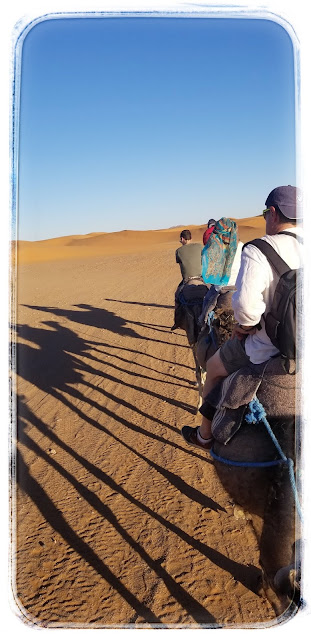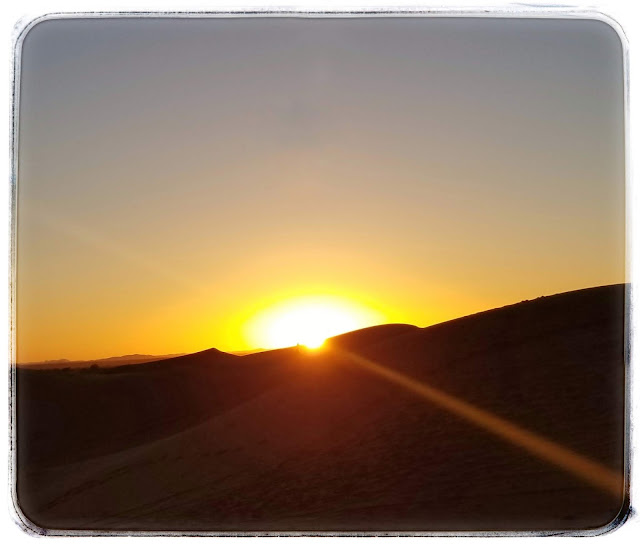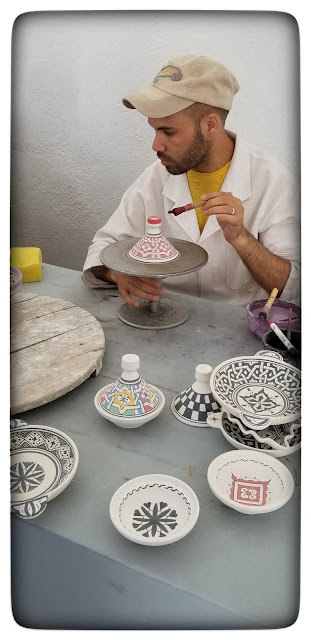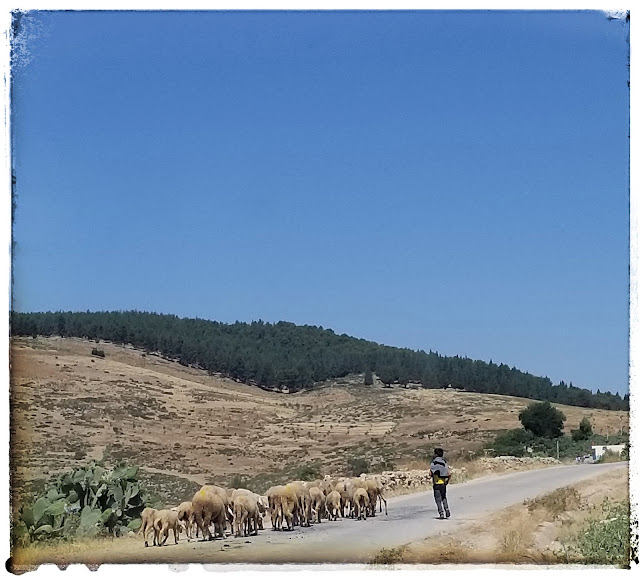All the walking in the Old Towns of Morocco prepared us for our whirlwind tour of London today. I think we did a pretty good job of cramming in as much as possible in our brief stopover. We saw a lot of the highlights: Paddington Station, Kings Cross, London Bridge, Tower Bridge, Borough Market, The Eye, Big Ben (under restoration), Berry Brothers & Rudd, Trafalgar Square, Fortnum & Mason, and, not to be missed, Buckingham Palace, including The Canada Gate.
Somewhere in there, we stopped for some traditional British grub for lunch at Sherlock Holmes'.
To top off the day, before heading to the airport, we had tea, of course.
That's it for our 2019 Moroccan Voyage (+a day in London)!

Last Day in Morocco
Our flight out of Morocco wasn't until the evening, so we headed back to the Big Square to wander through the souks in the Old Town.
After lunch, we went to The Secret Garden. It is a recreation of a garden that existed 150 years ago. The original hydraulic system, a thousand year old technique utilizing underground canals and gravity to distribute water and feed the garden still exists today. The exquisitely handcrafted replicas of the decorations enhance the beauty and peacefulness of this oasis hidden in the middle of the city.
We're almost finished our summer adventure, but first: one stop in London, UK.
After lunch, we went to The Secret Garden. It is a recreation of a garden that existed 150 years ago. The original hydraulic system, a thousand year old technique utilizing underground canals and gravity to distribute water and feed the garden still exists today. The exquisitely handcrafted replicas of the decorations enhance the beauty and peacefulness of this oasis hidden in the middle of the city.
We're almost finished our summer adventure, but first: one stop in London, UK.
Yves Saint Laurent
Today we visited two museums and a garden.
The Yves Saint Laurent Museum displays a timeline of the designer's career and accomplishments and exhibits some of his pieces and accessories.
Next to the museum is the Jardin Majorelle. Initially created by the artist Jaques Majorelle, but purchased and revived by YSL and Pierre Bergé after it had been abandoned years following the artist's death. The garden is a composition of palms, succulents, and bamboo, with ponds and planters of vivid hues.
Within this garden is another museum; this one dedicated to the Berber culture. It is located in the former painting studio of Jaques Majorelle. It contains over 600 Berber artifacts and the building itself is a vivid "Mojorelle" blue accent in the garden.
For our last dinner in Morocco, we went back into the Old Town and found a little hole in the wall (literally, sort of).
It was fabulous.
The Yves Saint Laurent Museum displays a timeline of the designer's career and accomplishments and exhibits some of his pieces and accessories.
Next to the museum is the Jardin Majorelle. Initially created by the artist Jaques Majorelle, but purchased and revived by YSL and Pierre Bergé after it had been abandoned years following the artist's death. The garden is a composition of palms, succulents, and bamboo, with ponds and planters of vivid hues.
Within this garden is another museum; this one dedicated to the Berber culture. It is located in the former painting studio of Jaques Majorelle. It contains over 600 Berber artifacts and the building itself is a vivid "Mojorelle" blue accent in the garden.
For our last dinner in Morocco, we went back into the Old Town and found a little hole in the wall (literally, sort of).
It was fabulous.
A Mosque, Two Palaces and Two Museums
We started our walking tour, again led by Jasmin, at the Koutoubia mosque. It is a large 12th century mosque, still in use today.
Next we visited the El Badii Palace which was quite large, but very much in ruins. The sunken garden containing orange groves, however, still flourishes. It was built in the16th century and although it was a palace, part of the underground rooms that housed the servants, also served as a prison.
The second palace of the day, Bahia Palace, was smaller (only 160 rooms and courtyards and 8 acres of gardens) and newer (19th century). It was also much better preserved. Everywhere we wandered, we admired the intricately detailed mosaics, carvings, ceilings, courtyards, fountains, garden... there was no end of allure.
Our first museum was the Museum of Tiskiwin. A small museum of Berber history and artifacts. It was quite interesting.
Dar Si Said, the final museum of the day, was a museum of Moroccan carpets. Videos and tools explained and demonstrated the carpet making process from shearing the sheep to weaving the final product. The patterns, colours, and weaving styles vary from region to region, making the origin of a carpet easier to identify. It was pretty cool.
Next we visited the El Badii Palace which was quite large, but very much in ruins. The sunken garden containing orange groves, however, still flourishes. It was built in the16th century and although it was a palace, part of the underground rooms that housed the servants, also served as a prison.
The second palace of the day, Bahia Palace, was smaller (only 160 rooms and courtyards and 8 acres of gardens) and newer (19th century). It was also much better preserved. Everywhere we wandered, we admired the intricately detailed mosaics, carvings, ceilings, courtyards, fountains, garden... there was no end of allure.
Our first museum was the Museum of Tiskiwin. A small museum of Berber history and artifacts. It was quite interesting.
Dar Si Said, the final museum of the day, was a museum of Moroccan carpets. Videos and tools explained and demonstrated the carpet making process from shearing the sheep to weaving the final product. The patterns, colours, and weaving styles vary from region to region, making the origin of a carpet easier to identify. It was pretty cool.
Pool Day
Today we split up for a bit. Some went to the Photography Museum, while others stayed at the riad.
The museum goers rode in a tuk-tuk that took them the "scenic route" to the museum.
The rest of the day was spent hanging by the pool. (It was open!)
The museum goers rode in a tuk-tuk that took them the "scenic route" to the museum.
The rest of the day was spent hanging by the pool. (It was open!)
Exploring Marrakesh
Today we started a walking tour to explore Marrakech, led by Jasmin. It started with our first stop closed for renovations (a common theme during this trip), but that didn't deter us. We moved on to the Marrakesh museum which was a combination historical and modern art exhibits. An artist on site painted the girl's name for them in Arabic calligraphy.
Afterwards we wandered through the alleys of the souk that opened on to a big main square with spices, and produce, and...snakes!
We wanted to end the day in the pool, but it was closed. Friday. We'll try again tomorrow.
We wanted to end the day in the pool, but it was closed. Friday. We'll try again tomorrow.
Road to Marrakesh
Our drive out of the desert took us through the City of Roses. Here they grow and harvest roses to make rose water and rose oil products. One kilo of rose petals produces 1L of rose water. Four tons are needed to make 1L of oil!
Along the way, in the distance, we could see the tower and reflections coming off the world's largest solar array situated in the desert.
We made a quick stop in at the Atlas Studios and glimpsed some old sets and props from their various movies.
Further down the road we stopped at Ait Benhaddou and climbed to the top. It's a 17th century ksar (fort) built in the foothills that was used in the filming of Gladiators and Game of Thrones.
Our last stop before descending through the Atlas mountains was to see an Argan oil demonstration. Argan trees are almond or peanut-type trees that are native only to Morocco. The nuts are harvested to make cosmetic hair and skin products, cooking oil, and edible butter.
The road through the mountains was a little harrowing as most of the winding route was under construction and Moroccans have a different style of driving than we do. The majestic views, however, were amazing.
Reaching Marrakesh, the end of our desert trek, our driver dropped us off at our new temporary home. A riad (with a pool!) just outside the Old Town.
Along the way, in the distance, we could see the tower and reflections coming off the world's largest solar array situated in the desert.
We made a quick stop in at the Atlas Studios and glimpsed some old sets and props from their various movies.
Further down the road we stopped at Ait Benhaddou and climbed to the top. It's a 17th century ksar (fort) built in the foothills that was used in the filming of Gladiators and Game of Thrones.
Our last stop before descending through the Atlas mountains was to see an Argan oil demonstration. Argan trees are almond or peanut-type trees that are native only to Morocco. The nuts are harvested to make cosmetic hair and skin products, cooking oil, and edible butter.
The road through the mountains was a little harrowing as most of the winding route was under construction and Moroccans have a different style of driving than we do. The majestic views, however, were amazing.
Reaching Marrakesh, the end of our desert trek, our driver dropped us off at our new temporary home. A riad (with a pool!) just outside the Old Town.
Oasis
The night in the Sahara was very comfortable in our luxury tents, complete with flushing toilets and a shower. Since it was after midnight when we went to bed, we opted not to get up to watch the sunrise over the dunes. This didn't make that big of a difference to our plans to sleep in since hiding from the sun in the desert is pointless. It wasn't long before our tent was perforated with sunlight. After an early breakfast, we explored the area near our camp for a while, but that inescapable sun was also heating things up and it was already 41°C by 8:30am.
Rather than commute back to town by camel, we decided to pile into a SUV and be shuttled back. I must say, bounding over the dunes in this 4x4 was not for the faint of heart. It rivaled any white knuckle rollercoaster ride I've ever been on in The West.
Back in town, we climbed into our waiting van to continue our exploration through the desert.
We stopped to check out a now defunct underground water canal, called a qanat, that had been hand dug as early as the 14th century and maintained as recently as 1970. Qanats are gently inclined horizontal tunnels dug into sloping terrain, as opposed to a vertical well dug straight to the water table. They were used to transport water vast distances to some of the oases in the desert.
As we continued to drive, the seemingly flat vista would fall away to reveal a deep gorge oasis carved into the landscape by a river that has eroded and nourished the parched desert soil for centuries.
It's fascinating how quickly and dramatically a water source can turn the dusty, dry, rocky land into a lush, green, Palm grove.
Our hotel for the night, overlooks one of these flourishing oasis.
Rather than commute back to town by camel, we decided to pile into a SUV and be shuttled back. I must say, bounding over the dunes in this 4x4 was not for the faint of heart. It rivaled any white knuckle rollercoaster ride I've ever been on in The West.
Back in town, we climbed into our waiting van to continue our exploration through the desert.
We stopped to check out a now defunct underground water canal, called a qanat, that had been hand dug as early as the 14th century and maintained as recently as 1970. Qanats are gently inclined horizontal tunnels dug into sloping terrain, as opposed to a vertical well dug straight to the water table. They were used to transport water vast distances to some of the oases in the desert.
As we continued to drive, the seemingly flat vista would fall away to reveal a deep gorge oasis carved into the landscape by a river that has eroded and nourished the parched desert soil for centuries.
It's fascinating how quickly and dramatically a water source can turn the dusty, dry, rocky land into a lush, green, Palm grove.
Our hotel for the night, overlooks one of these flourishing oasis.
Into the Desert (all the way)
This morning we started our trek into the desert. Our guide/driver loaded us into his van bright and early and we headed off.
Our first stop was in Ifrane for breakfast. The Moroccans call the town "The Swiss Alps" or "European Town" of Morocco. It is up in the Middle Atlas mountains, so it gets snow. Because of the snow, the houses all have steep peaked roofs (evoking Swiss or European resemblance) rather than the flat-roofed, box-like homes seen everywhere else. They even have a Ski Station up here, but apparently they have no proper machinery to clear the roads, except of course, for the king, who does come to ski.
Not far from Ifrane, we stopped on the side of the road to feed monkeys. They were very accustomed to tourists and had no fear approaching us for food (cherries and peanuts). One was bold enough to snatch the bag of peanuts out of Dave's hand before he had a chance to open it.
After a long drive through the mountains and into the desert we finally reached Merzouga.
We traded the luxury of our AC van to climb on top of camels and head into the hot, dry sand dunes of the Sahara. In a short time, our camel guide led our little caravan where we could no longer see the town and were surrounded by sand banks. We did not feel that we were alone, however, other camel caravans could be seen in the distance and the occasional ATV would pop over a ridge and disappear again.
Before reaching camp, we stopped to climb a little higher by foot, to a ridge to watch the sunset.
Some couldn't resist playing in the giant sandbox.
When we reached our camp, tea was, of course, served.
In the evening, after a tradional Berber dinner we stepped away from the light of our camp to star gaze. The sky was magnificent; suffused with so many celestial beings!
Before bed, we sat around a camp fire and listened while our Berber hosts played drums and sang songs. We even did a little dancing and drumming too.
Our first stop was in Ifrane for breakfast. The Moroccans call the town "The Swiss Alps" or "European Town" of Morocco. It is up in the Middle Atlas mountains, so it gets snow. Because of the snow, the houses all have steep peaked roofs (evoking Swiss or European resemblance) rather than the flat-roofed, box-like homes seen everywhere else. They even have a Ski Station up here, but apparently they have no proper machinery to clear the roads, except of course, for the king, who does come to ski.
Not far from Ifrane, we stopped on the side of the road to feed monkeys. They were very accustomed to tourists and had no fear approaching us for food (cherries and peanuts). One was bold enough to snatch the bag of peanuts out of Dave's hand before he had a chance to open it.
After a long drive through the mountains and into the desert we finally reached Merzouga.
We traded the luxury of our AC van to climb on top of camels and head into the hot, dry sand dunes of the Sahara. In a short time, our camel guide led our little caravan where we could no longer see the town and were surrounded by sand banks. We did not feel that we were alone, however, other camel caravans could be seen in the distance and the occasional ATV would pop over a ridge and disappear again.
Before reaching camp, we stopped to climb a little higher by foot, to a ridge to watch the sunset.
Some couldn't resist playing in the giant sandbox.
When we reached our camp, tea was, of course, served.
In the evening, after a tradional Berber dinner we stepped away from the light of our camp to star gaze. The sky was magnificent; suffused with so many celestial beings!
Before bed, we sat around a camp fire and listened while our Berber hosts played drums and sang songs. We even did a little dancing and drumming too.
Henna and Weaver
Today was our last day in Fes.
We returned to the souk to have Henna tattoos put on the girls hands. As a little bonus, the artist also wrote each of the girls' names in Arabic.
While they were getting painted, we admired more of the detailed Fes architecture.
Afterwards, we were led upstairs in a textiles shop to watch weavers working away on the looms. Once again, we admired the craftsmanship of the beautiful fabric created.
Our last dinner in Fes was at a rooftop restaurant that looked across the whole Old Town. We watched the sunset over the city and even spied our palace room in the distance.
We returned to the souk to have Henna tattoos put on the girls hands. As a little bonus, the artist also wrote each of the girls' names in Arabic.
While they were getting painted, we admired more of the detailed Fes architecture.
Afterwards, we were led upstairs in a textiles shop to watch weavers working away on the looms. Once again, we admired the craftsmanship of the beautiful fabric created.
Our last dinner in Fes was at a rooftop restaurant that looked across the whole Old Town. We watched the sunset over the city and even spied our palace room in the distance.
Cereamics and Carpets
A member of the staff from our palace took us to a ceramic factory today.
We learned about the type of clay unique to Fes - white, volcanic, as opposed to red, found elsewhere in Morocco. Our guide showed us demonstrations of the different steps involved from molding the clay, painting pottery, cutting tiles, and the setting the pattern for a table top or fountain.
Alia got to try her hand at molding a plate on the wheel. She did a great job.
As artists painted pots and plates, our guide described the difference between Berber, Arabic and Jewish patterns and how many of the pottery have combinations of two, or all three.
We watched a man with a ice-pick-type hammer, chip away tiny stars out of a tile.
On the floor there was a work-in-progress of the setting of the pattern for a tabletop. Each tiny tile is place upside-down before they are cemented together to create the intricate surface.
After the ceramic factory, we visited a carpet shop in the souk and learned about the creation and ways to identify an authentic Berber carpet. Apparently, they are made by "crazy ladies" in the Atlas mountains and only have tassels at one end, so that the length of the carpet can be changed.
It was quite amazing to watch and learn about the craftmanship that go into the ceramics and carpets.
We learned about the type of clay unique to Fes - white, volcanic, as opposed to red, found elsewhere in Morocco. Our guide showed us demonstrations of the different steps involved from molding the clay, painting pottery, cutting tiles, and the setting the pattern for a table top or fountain.
Alia got to try her hand at molding a plate on the wheel. She did a great job.
As artists painted pots and plates, our guide described the difference between Berber, Arabic and Jewish patterns and how many of the pottery have combinations of two, or all three.
We watched a man with a ice-pick-type hammer, chip away tiny stars out of a tile.
On the floor there was a work-in-progress of the setting of the pattern for a tabletop. Each tiny tile is place upside-down before they are cemented together to create the intricate surface.
After the ceramic factory, we visited a carpet shop in the souk and learned about the creation and ways to identify an authentic Berber carpet. Apparently, they are made by "crazy ladies" in the Atlas mountains and only have tassels at one end, so that the length of the carpet can be changed.
It was quite amazing to watch and learn about the craftmanship that go into the ceramics and carpets.
Volubilis and Meknes
Our daytrip excursion took us through the countryside up narrow, mountainside roads through olive groves and sheep herds (literally).
Our GPS even routed us right into a full street market in progress. We had no choice but to keep moving forward (slowly) through the crowd. It was quite entertaining.
Our first destination was Volubilis. Roman and Berber ruins that date back to the 3rd century. Only a fraction of the expansive city has been excavated. We wandered the ancient streets, marvelling at the massive columns and intricate mosaics.
We headed back to Fes through Meknes, where we stopped for lunch and explored the Prison de Kara, an 18th century, subterranean prison (it was nice and cool in there); as well as the market (on foot this time).
In the evening, Dave and I attended a concert by "Quelle Distance Entre Le Soleil et La Terre ?" which was part of a week long International Music Festival in Fes. The concert performers were local children and adolescents from Fes. They created and produced the material which was a compliation of singing, dance, poetry and mime. The venue was a local museum and the performance was presented as the exhibition, so we progressed together through the rooms with the artists to watch them perform.
Afterwards we had dinner at a rooftop restaurant overlooking Fes, right next to a mosque. We had good food and fabulous views.
Tannery
"Closed" Souk (Market) to the Chouara Tannery. It's Friday so the markets are supposed to be closed. And they are, for the most part, after 2pm. But some shrewd vendors know the tourists will shop on a Friday, so a few shops were open. I prefer this lesser-crowded vibe of the souk. The narrow streets get to be pretty cramped on a regular day.
Down in the heart of the souk is the Chouara Tannery. From the top floor balcony of the shop, we looked out over the field of emmense vats. Some vats contain quicklime, salt, or pigeon poop (yes, that's what I said - pigeon poop - it's collected by locals in their rooftop coups and brought to the tannery). These are used to clean and prepare the hides - camel, cow, sheep, or goat. Other vats contain only natural dyes, used to colour the hides made from poppy flowers, tumeric, indigo, saffron, etc.
It was fascinating (and a little aromatic, thanks to the pigeon poop), to see this tradional, authentic operation.
Subscribe to:
Comments (Atom)




















































